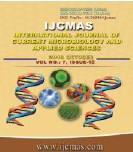


 National Academy of Agricultural Sciences (NAAS)
National Academy of Agricultural Sciences (NAAS)

|
PRINT ISSN : 2319-7692
Online ISSN : 2319-7706 Issues : 12 per year Publisher : Excellent Publishers Email : editorijcmas@gmail.com / submit@ijcmas.com Editor-in-chief: Dr.M.Prakash Index Copernicus ICV 2018: 95.39 NAAS RATING 2020: 5.38 |
In order to assess the effect of manuring, growth regulators and chemicals on the vegetative and reproductive character of tamarind in seed raised plantation through soil drenching and foliar application. The treatments namely T1 (5 kg Organic manuring), T2 (1 kg urea + 500 gm SSP + 1kg MOP), T3 (5 kg Organic manuring + 100 gm Borax), T4 (1 kg urea + 500 gm SSP + 1 kg MOP +100 gm Borax), T5 (1 % KNO3 Spray), T6 (2 % KNO3 Spray), T7 (1 % K2HPO4 Spray), T8 (2 % K2HPO4 Spray), T9 (Cultar 2000 ppm - Soil drenching), T10 (Cultar 3000 ppm - Soil drenching), T11 (Cultar 4000 ppm Soil drenching) and T12 (Control) were applied in tamarind plantation at Mullangaddu (Boluvampatti), Coimbatore district, Tamil Nadu, India. Vegetative and reproductive characters of tamarind were significantly improved by the application of manuring, growth regulators and chemicals. The length of terminal shoot (22.14 cm and 19.47 cm), length of auxillary shoot (9.45 and 8.94 cm) days to first flowering (103.50 and 101.20), percentage of trees flowered (86.16 % and 86.66 %), length of inflorescence (13.26 and 5.40), no. of fruits /inflorescence (1.56 and 1.25), percentage of initial fruit set (6.409 and 7.716) and percentage fruit retention (1.228 and 1.250) were recorded maximum by the foliar application of 2 % KNO3 and soil drenching of cultar 3000 ppm. The lowest vegetative and reproductive character was observed in control (no manuring and growth regulator application). To conclude the study, the 2 % KNO3 and cultar 3000 ppm in the tamarind tree enhanced the nutrient status in the tamarind leaves and hence it can contribute to fruit yield in tamarind plantations.
 |
 |
 |
 |
 |